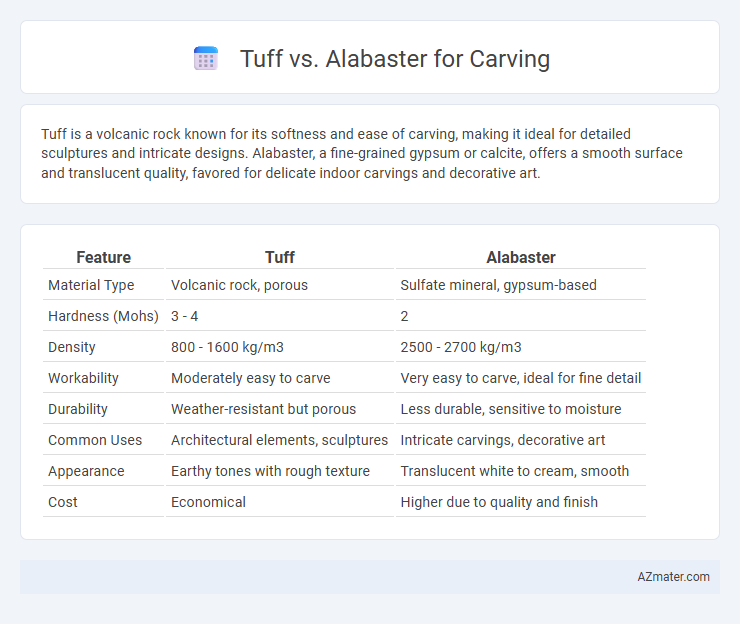Tuff is a volcanic rock known for its softness and ease of carving, making it ideal for detailed sculptures and intricate designs. Alabaster, a fine-grained gypsum or calcite, offers a smooth surface and translucent quality, favored for delicate indoor carvings and decorative art.
Table of Comparison
| Feature | Tuff | Alabaster |
|---|---|---|
| Material Type | Volcanic rock, porous | Sulfate mineral, gypsum-based |
| Hardness (Mohs) | 3 - 4 | 2 |
| Density | 800 - 1600 kg/m3 | 2500 - 2700 kg/m3 |
| Workability | Moderately easy to carve | Very easy to carve, ideal for fine detail |
| Durability | Weather-resistant but porous | Less durable, sensitive to moisture |
| Common Uses | Architectural elements, sculptures | Intricate carvings, decorative art |
| Appearance | Earthy tones with rough texture | Translucent white to cream, smooth |
| Cost | Economical | Higher due to quality and finish |
Introduction to Tuff and Alabaster
Tuff is a lightweight volcanic rock formed from compacted volcanic ash, prized for its softness and ease of carving, making it a popular choice for large sculptures and architectural decorations. Alabaster, a fine-grained sedimentary gypsum or calcite stone, is renowned for its smooth texture, translucency, and ability to hold intricate details, often favored for delicate and ornamental carving. Both stones offer unique properties that influence their selection for various artistic and structural applications, with Tuff providing durability and Alabaster offering aesthetic refinement.
Geological Origins and Composition
Tuff, a volcanic rock formed from consolidated volcanic ash, consists primarily of fragmented volcanic glass and minerals such as quartz and feldspar, making it softer and easier to carve than many other stones. Alabaster, derived mainly from the evaporite mineral gypsum, is a fine-grained sedimentary rock composed of calcium sulfate dihydrate, notable for its smooth texture and translucency. The volcanic origins of tuff contrast with the sedimentary genesis of alabaster, affecting their hardness, workability, and typical use in detailed sculptural carving.
Physical Properties Comparison
Tuff is a volcanic rock known for its lightweight and porous texture, making it easier to carve but less durable compared to alabaster. Alabaster is a denser, finer-grained gypsum or calcite stone with a smooth surface, offering greater detail and polish in carving but requiring more effort to shape. The hardness of tuff ranges around 3 on the Mohs scale, whereas alabaster typically scores around 2, indicating alabaster's softer characteristic despite its higher density.
Workability and Carving Techniques
Tuff offers excellent workability due to its relatively soft and porous nature, allowing carvers to use basic hand tools and achieve fine details with ease. Alabaster, softer and smoother, is ideal for intricate and delicate carving techniques, enabling artists to create polished surfaces and complex shapes effortlessly. Both materials respond well to chiseling and sanding, but alabaster's fine grain allows for greater precision in detailed sculpting.
Durability and Longevity
Tuff, a volcanic rock with a moderate hardness rating of 3-4 on the Mohs scale, offers excellent durability and resistance to weathering, making it suitable for outdoor carving projects requiring long-lasting stability. Alabaster, a softer mineral with a hardness of 2-2.5, provides smoother carving detail but is more prone to scratches, erosion, and damage from moisture exposure, limiting its longevity in harsh environments. For sculptures or architectural elements demanding extended durability, tuff's robust composition ensures a longer lifespan compared to the more delicate alabaster.
Aesthetic Appeal and Color Variations
Tuff is prized for its warm, earthy tones ranging from soft browns to reddish hues, offering a rustic and natural aesthetic ideal for outdoor sculptures and large installations. Alabaster provides a smooth, translucent quality with subtle shades of white, cream, and pale pink, enhancing fine details and giving carvings an elegant, luminous finish suitable for intricate indoor artworks. The color variations in tuff emphasize texture and depth, while alabaster's palette highlights purity and delicacy in carved forms.
Common Uses in Art and Architecture
Tuff is widely favored in architecture for its durability and ease of carving, often used in historic buildings, sculptures, and ornamental facades due to its porous texture and warm color tones. Alabaster, prized in art, is commonly utilized for fine detailed sculptures, decorative vases, and intricate reliefs because of its smooth surface and translucent quality that enhances light diffusion. Both materials serve distinct roles: tuff offers structural strength and rustic appeal in architectural elements, while alabaster allows for delicate artistic expressions in interior design and small-scale artworks.
Cost and Availability
Tuff is generally more affordable and widely available for carving due to its volcanic origin and abundance in regions like Italy and Iceland, making it a cost-effective choice for sculptors. Alabaster, a softer and more translucent material, tends to be pricier and less accessible, often sourced from limited quarries in places such as Italy and Egypt. The higher cost of alabaster reflects its finer quality and desirability for detailed sculptures, whereas tuff offers budget-friendly options with good workability.
Maintenance and Preservation Tips
Tuff is a dense volcanic rock with high durability, requiring minimal maintenance and resisting weathering well, making it ideal for outdoor carving projects. Alabaster, a softer, more porous mineral, demands careful handling, frequent dusting, and protection from moisture to prevent surface damage and discoloration. Preservation of alabaster sculptures involves sealing with specialized coatings and avoiding exposure to harsh chemicals, while tuff carvings benefit from occasional cleaning with mild detergents to maintain their texture and color.
Choosing the Right Stone for Your Project
Tuff offers a lightweight, porous texture that makes it easier to carve intricate designs, ideal for detailed projects requiring fine precision. Alabaster, known for its smooth, translucent surface, provides a polished finish and is better suited for sculptures emphasizing elegance and light diffusion. Choosing between tuff and alabaster depends on project requirements such as carving complexity, durability, and aesthetic preferences.

Infographic: Tuff vs Alabaster for Carving
 azmater.com
azmater.com